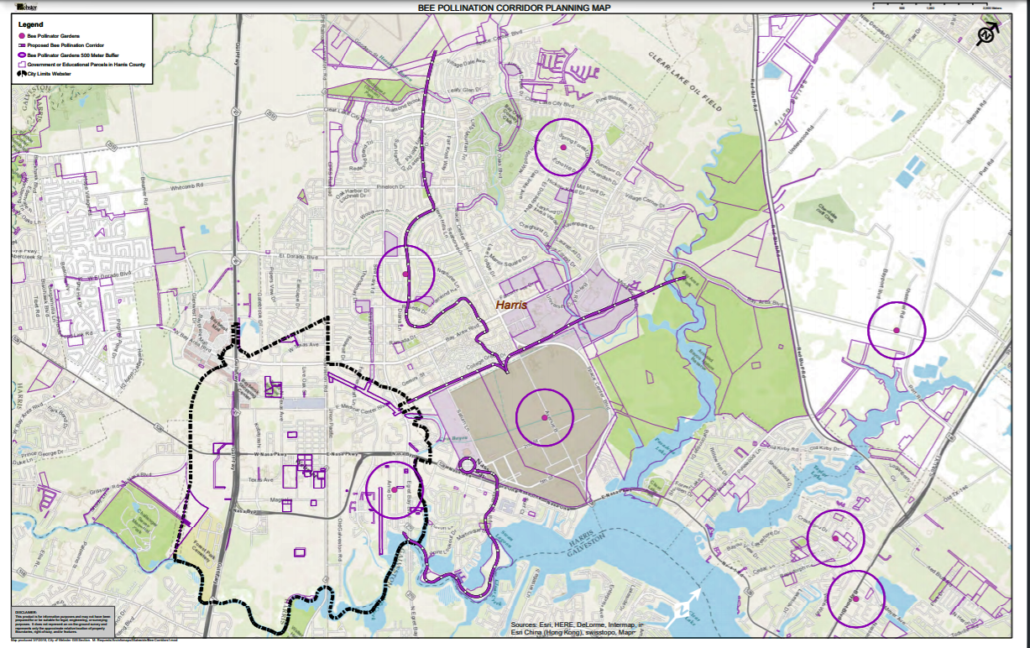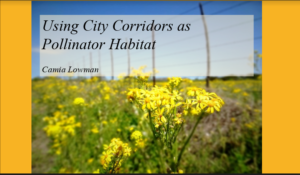Pollinator pathways, flyways, corridors, and prairies
People across the globe are connecting their pollinator-friendly landscapes, and creating long pollinator pathways throughout entire regions to help pollinators navigate between urban and rural environments as they forage.
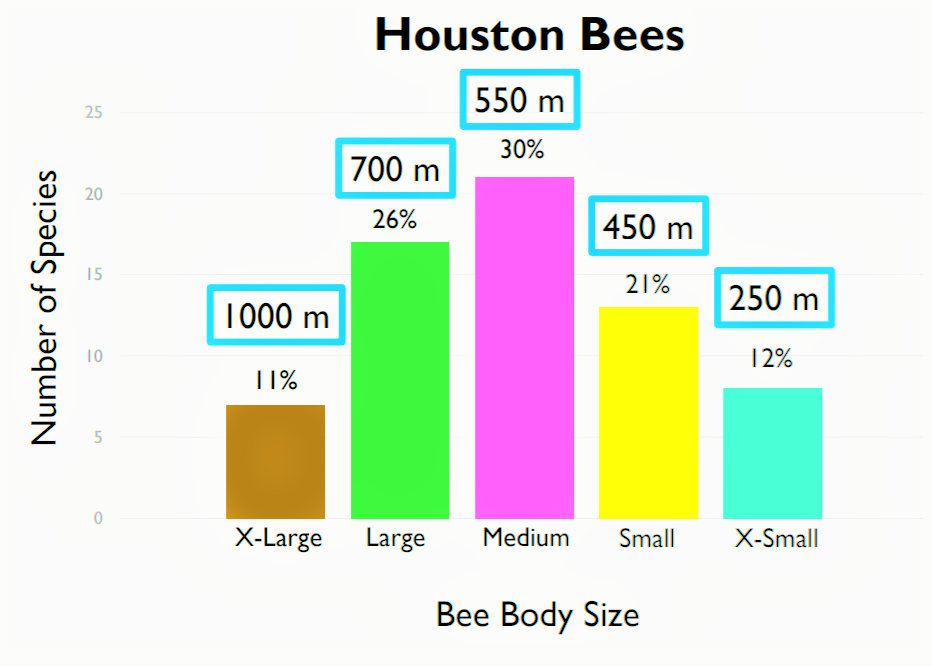
Bee size determines how far they can forage before needing more food. The graph shows percentage of bees in Houston based on body size and the distance they usually fly to forage. Small species can go about 200 yards, and large bees as far as a mile.
You can start a pollinator pathway, or connect to one. To participate, the landscape or garden design must support pollinators with a diversity of flowering plants and using pollinator-friendly landscape management practices.
Some examples of regional pollinator pathway projects include: the Katy Prairie Conservancy Pocket Prairie; the Houston Zoo Prairie Pollinator Pathway; the Houston Wilderness Texas Monarch Flyway Strategy; and the Monarch Highway, the I-35 corridor which is part of the central monarch migration flyway through Texas, Oklahoma, Kansas, Missouri, Iowa, and Minnesota!
Cities may be the key to help save bees!
Cities are in a unique position to create a safe haven for pollinators. Bee species diversity and abundance is actually GREATER in cities than in surrounding rural areas. (Baldock et al, 2015) (Sirohi et al, 2015) (M’Gonigle et al, 2015). The Nature Of Cities.
How can cities help pollinators?
Cities can help pollinators by modifying their landscape maintenance habits:
- provide food year-round with diverse plants that flower in each season
- provide nesting areas with bare ground (no mulch) or soft wood to live in
- provide wildlife habitat for pollination and pest control
- use less toxic or organic pesticide alternatives
In return, cities and citizens benefit:
- improve drainage, reduce soil erosion
- improve water and air quality
- reduce air pollution and urban heat island effect
- improve noise, environment buffers along corridors
Underused land types that could be converted to pollinator flyways:
- Vacant Lots, Alleys
- Roadside Strips, Medians, Berms
- Surface Parking Lots
- Residential Lawns
- Commercial Property
- Municipal Property, Community Greenspaces
- Rooftop Spaces
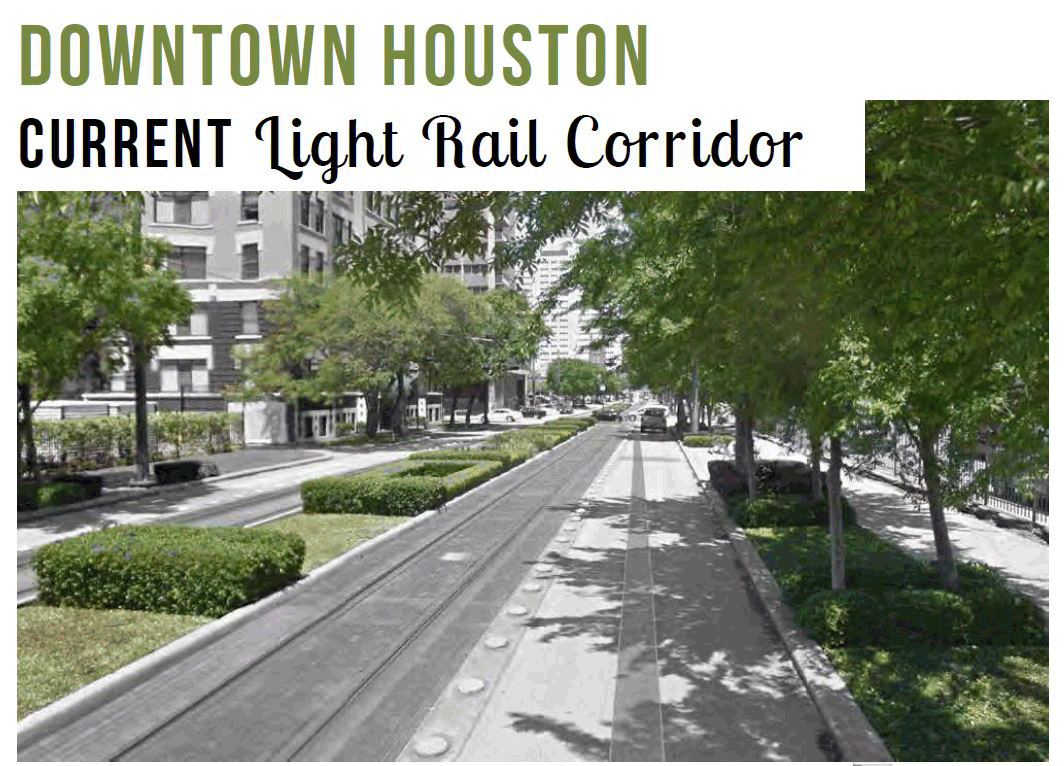
City of Houston proposed pollinator corridor
The image shows how the Houston Light Rail corridor can be transformed into a pollinator corridor. The design is by Danielle Bilot, landscape architect, consultant on urban habitats, and professor of environmental design at University of Colorado Boulder.
Danielle chose America’s 4th largest city, Houston, as her beta site because it has the largest concentration of surface parking lots (18%). This city pollinator corridor design is adaptable and includes a variety of year-round food foraging plots, which measure 15-18 square feet. 80% are for foraging and 20% are for nesting (75% ground, 25% wood).
City of Webster proposed bee corridor
HoustonNativeBees was contacted by the City Planner of the City of Webster to help design a pollinator pathway along the city’s bike/running path. The idea grew from having one isolated pollinator garden, to inter-connected pollinator-friendly landscaping along the entire bike path.
In addition, citizens were able to connect their gardens to the Webster Bee Corridor. Many citizens were eager to participate, then I was contacted by representatives from Johnson Space Center, The Houston Zoo, people from surrounding communities, public and private organizations and businesses. What a great response!
Using city corridors as pollinator habitat
Presentation to Houston-Galveston Area Council, Parks and Natural Areas Subcommittee, and City of Webster, on adding pollinator gardens to planned bike paths.
Houston Heat Map
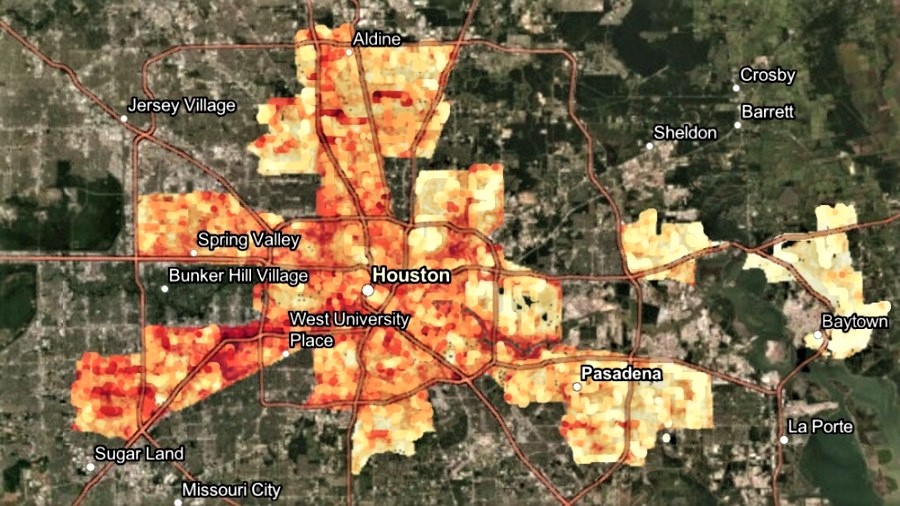
How hot is your neighborhood? Cities are generally hotter than surrounding rural areas and suburbs, a phenomenon known as the urban heat island effect.
Image: NOAA (National Oceanic and Atmospheric Administration) 2020
Houston Harris Heat Action Team: www.h3at.org
In July 2021, Rice University Kinder Institute for Urban Research reviewed a study by American Forests, and posted information about Houston neighborhoods along with their approximate land tree canopy coverage (shade) and average temperatures.
Temperatures can vary up to 20 degrees depending on density of tree canopy, pavement, and concrete. For example: West U, 38% shade, avg. temp. 83º; Central Gulfton, 6% shade, avg. temp. 90º; Heights Boulevard, 34% shade, avg. temp 85º; Kirby Drive, 48% shade, avg. temp 80º; Alief, 11% shade, avg. temp. 90º.
Kinder recommends “tree equity” by planting more trees (2.4 million). This would add green infrastructure and increase coverage by about 23%, help mitigate stormwater runoff, and would benefit pollinators!
Nonprofits such as Trees For Houston and Tree Peace distribute and plants trees throughout Houston.


